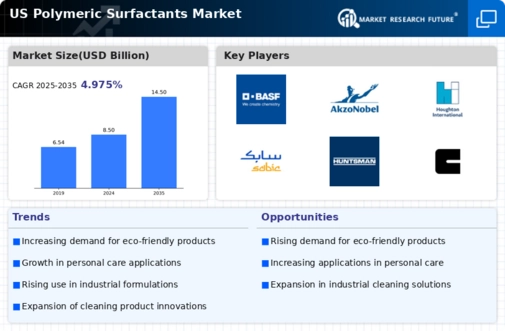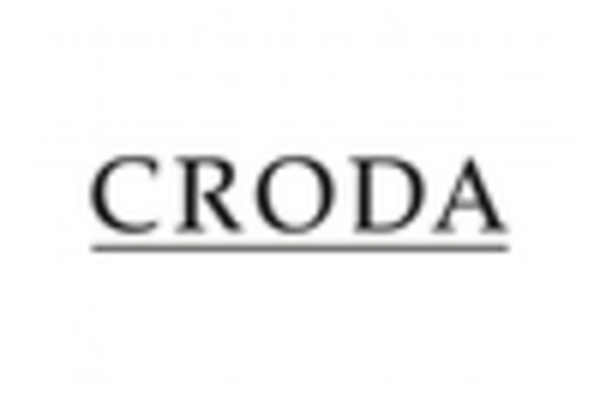Expansion in Industrial Applications
The polymeric surfactants market is witnessing an expansion in its application across various industrial sectors, including textiles, paints, and coatings. These surfactants play a crucial role in improving the performance characteristics of industrial formulations, such as enhancing stability and reducing surface tension. The textile industry, in particular, is increasingly adopting polymeric surfactants to improve dyeing processes and fabric treatments. This sector is projected to contribute approximately 20% to the market by 2026. Moreover, the coatings industry is also leveraging polymeric surfactants to achieve better dispersion and stability in formulations, which is essential for high-quality finishes. As industries continue to innovate and seek improved performance, the demand for polymeric surfactants is likely to grow.
Growth in Household Cleaning Products
The polymeric surfactants market is significantly benefiting from the expansion of the household cleaning products sector. With a growing emphasis on hygiene and cleanliness, particularly in urban areas, the demand for effective cleaning agents is on the rise. Polymeric surfactants are integral to formulating efficient cleaning products, as they enhance the wetting and emulsifying properties, leading to superior cleaning performance. The household cleaning segment is expected to represent around 25% of the market by 2026, driven by consumer awareness and the need for effective solutions against dirt and grime. Additionally, the shift towards eco-friendly cleaning products is prompting manufacturers to explore polymeric surfactants that are biodegradable and less harmful to the environment, further stimulating market growth.
Rising Demand in Personal Care Products
The polymeric surfactants market is experiencing a notable surge in demand, particularly within the personal care sector. This growth is driven by the increasing consumer preference for high-performance and multifunctional products. Polymeric surfactants are favored for their ability to enhance the texture and stability of formulations, making them essential in shampoos, conditioners, and lotions. The personal care segment is projected to account for approximately 30% of the overall market share by 2026, reflecting a robust growth trajectory. As consumers become more discerning about product quality, manufacturers are compelled to innovate, thereby propelling the polymeric surfactants market forward. Furthermore, the trend towards natural and organic ingredients is influencing the formulation of personal care products, leading to an increased incorporation of polymeric surfactants that meet these criteria.
Technological Innovations in Manufacturing
The polymeric surfactants market is being propelled by technological innovations in manufacturing processes. Advances in production techniques are enabling manufacturers to create more efficient and sustainable surfactants, which are tailored to meet specific application needs. Innovations such as microencapsulation and the development of bio-based surfactants are gaining traction, allowing for enhanced performance and reduced environmental impact. This shift towards advanced manufacturing is expected to increase the market's competitiveness, with projections indicating a growth rate of around 5% annually through 2026. As companies invest in research and development, the polymeric surfactants market is likely to see a diversification of product offerings, catering to a broader range of applications.
Increased Focus on Environmental Regulations
The polymeric surfactants market is influenced by an increased focus on environmental regulations and sustainability practices. Regulatory bodies are imposing stricter guidelines on the use of chemicals in various industries, prompting manufacturers to seek eco-friendly alternatives. Polymeric surfactants that are biodegradable and derived from renewable resources are becoming more desirable as companies strive to comply with these regulations. This shift is expected to drive innovation within the market, as manufacturers develop new formulations that align with environmental standards. The market is anticipated to grow by approximately 4% annually as businesses adapt to these regulatory changes, ensuring that their products meet both consumer expectations and legal requirements.

















Leave a Comment